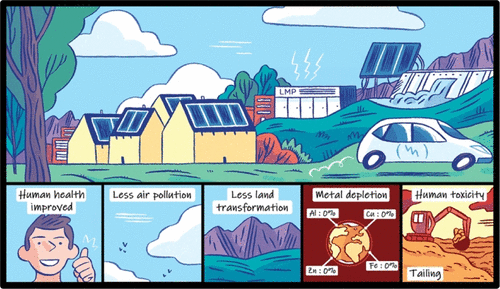当前位置:
X-MOL 学术
›
Environ. Sci. Technol.
›
论文详情
Our official English website, www.x-mol.net, welcomes your
feedback! (Note: you will need to create a separate account there.)
Energy System Pathways with Low Environmental Impacts and Limited Costs: Minimizing Climate Change Impacts Produces Environmental Cobenefits and Challenges in Toxicity and Metal Depletion Categories.
Environmental Science & Technology ( IF 10.8 ) Pub Date : 2020-03-30 , DOI: 10.1021/acs.est.9b06484 Laurent Vandepaer 1, 2 , Evangelos Panos 2 , Christian Bauer 2 , Ben Amor 1
Environmental Science & Technology ( IF 10.8 ) Pub Date : 2020-03-30 , DOI: 10.1021/acs.est.9b06484 Laurent Vandepaer 1, 2 , Evangelos Panos 2 , Christian Bauer 2 , Ben Amor 1
Affiliation

|
Environmental indicators based on the life cycle assessment method are integrated into an energy system model. This integration allows for the generation of comprehensive environmental assessments of future energy systems and for determining energy scenarios with less environmental impacts and moderate cost increases. In Switzerland, which is used as a case study to demonstrate the feasibility of our approach, it is possible to generate pathways with a 5% cost increase on the cost-optimal situation, causing an impact score for climate change that is 2% higher than the minimum feasible solution. The minimization of life-cycle impacts on climate change generates substantial environmental cobenefits with regard to human health, air pollution, ozone depletion, acidification, and land transformation. However, this minimization also creates trade-offs that exacerbate the effects of metal depletion and human toxicity caused by upstream extraction and manufacturing linked to technologies such as solar panels and electric vehicles. Finally, ambitious reduction targets of 95% direct (i.e., within the country) CO2 emissions for the year 2050 might still result in substantial climate change impacts should emissions embodied in the infrastructure and upstream supply chain not be jointly mitigated jointly.
中文翻译:

具有低环境影响和有限成本的能源系统途径:最小化气候变化影响在毒性和金属耗竭类别中产生环境效益和挑战。
基于生命周期评估方法的环境指标已集成到能源系统模型中。通过这种集成,可以对未来的能源系统进行全面的环境评估,并确定对环境的影响较小且成本增加适中的能源方案。在瑞士(作为案例研究来证明我们的方法的可行性),有可能在成本最优的情况下产生成本增加5%的路径,从而导致气候变化的影响得分比成本高2%。最小可行的解决方案。将生命周期对气候变化的影响降到最低,可在人类健康,空气污染,臭氧消耗,酸化和土地转化等方面产生巨大的环境效益。然而,这种最小化还产生了权衡取舍,加剧了与太阳能电池板和电动汽车等技术相关的上游开采和制造所造成的金属消耗和人体毒性的影响。最后,如果不能共同缓解基础设施和上游供应链中的排放量,那么到2050年将95%的直接(即在国内)CO2排放量削减目标的雄心勃勃仍可能对气候变化产生重大影响。
更新日期:2020-04-23
中文翻译:

具有低环境影响和有限成本的能源系统途径:最小化气候变化影响在毒性和金属耗竭类别中产生环境效益和挑战。
基于生命周期评估方法的环境指标已集成到能源系统模型中。通过这种集成,可以对未来的能源系统进行全面的环境评估,并确定对环境的影响较小且成本增加适中的能源方案。在瑞士(作为案例研究来证明我们的方法的可行性),有可能在成本最优的情况下产生成本增加5%的路径,从而导致气候变化的影响得分比成本高2%。最小可行的解决方案。将生命周期对气候变化的影响降到最低,可在人类健康,空气污染,臭氧消耗,酸化和土地转化等方面产生巨大的环境效益。然而,这种最小化还产生了权衡取舍,加剧了与太阳能电池板和电动汽车等技术相关的上游开采和制造所造成的金属消耗和人体毒性的影响。最后,如果不能共同缓解基础设施和上游供应链中的排放量,那么到2050年将95%的直接(即在国内)CO2排放量削减目标的雄心勃勃仍可能对气候变化产生重大影响。











































 京公网安备 11010802027423号
京公网安备 11010802027423号